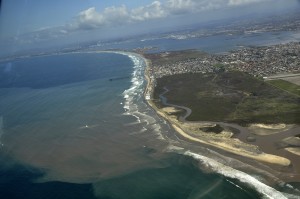
Photo of the Tijuana River plume in Imperial Beach, CA courtesy of WILDCOAST.
The connectivity between estuaries and the coastal ocean is important for the transport of sediments, nutrients, and contaminants. Much scientific research has been focused on processes within the estuary or the freshwater plume, with an emphasis on large plumes, separately. Less is known about how the two interact in the very nearshore environment, particularly regarding small river plumes. Grad student Angelica Rodriguez is investigating how small river plumes disperse in coastal waters. Of primary interest is the impact of wave-driven currents and turbulence in the surf zone and inner-shelf. This work is motivated by water quality concerns from small contaminated rivers and storm drain outfalls. With funding from the National Science Foundation GRFP and the Blasker-Rose-Miah Fund of The San Diego Foundation, Angelica has developed an idealized numerical model to investigate these processes.
Specifically, Angelica developed her numerical model based on the Tijuana River Estuary (pictured), located on the US-Mexico border. This estuary is less developed than many other Southern California Lagoons in terms of physical infrastructure, yet it experiences very poor water quality from upstream contamination. Nearby beaches are frequently closed due to contamination concerns. Thus, Angelica’s work seeks to help us better understand how these small plumes spread and impact coastal water quality. This work is related to an NSF project led by Falk Feddersen investigating dispersion of tracers along the coast and between the surf zone and inner-shelf: CSIDE – Cross Surfzone/Inner-shelf Dye Exchange.
Model Output
Due to file size limitations, model configuration files and results are available upon request by contacting Angelica R. Rodriguez or Sarah N. Giddings. Model configuration files and output files are curated by Rodriguez on Sarah N. Giddings’ server at SIO. Upon request, desired files can be posted on Rodriguez’s or Giddings’ UCSD Google Drive account with a temporary link.
